Making Spring Roll (Popiah) Skins

Now me, I grew up calling these sorts of devices “egg rolls.” It wasn’t until I got to be in high school that I began to know them as spring rolls. That was when one of my father’s oldest friends married a Chinese woman who happened to own one of the best Mandarin restaurants in Chinatown. We started eating there once a week, so I had to at least appear to know the lingo. These below are what I always thought were “spring rolls”:
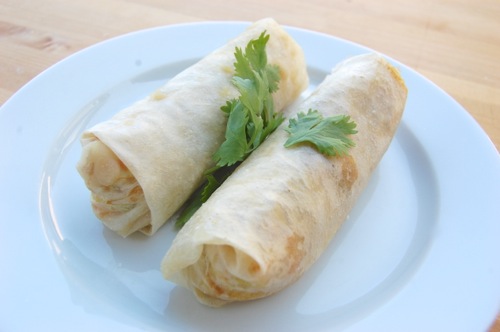
Turns out they’re both spring rolls, the difference is of course that up top we have fried spring rolls versus merely the rolled-up variety. Truth be told I still call them “egg rolls” when there’s no one around to correct me. Both are a lot of fun to make, mostly because the technique for making the skins is so ingeniously odd. You basically pick up a big blob of dough, dab it onto a pan and pick it up again. The film that remains is the wrapper. Cool eh? Ultra-thin pastry is really fascinating stuff.
Anyway, the name of this game is “developed gluten.” Without it the dough film won’t adhere to the pan. So you’ll need bread flour for sure, high gluten flour if you can find it. The recipe proceeds like this so. Combine your flour, water and salt in the bowl of a mixer fitted with the paddle.
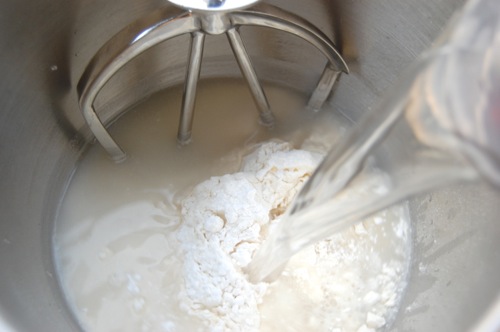
Stir that until a lumpy dough forms, about two minutes.
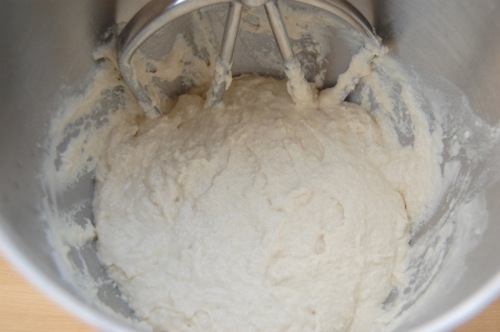
Now for something unusual. Pour in enough water to cover the dough you just made. Then stick the mixer bowl in the refrigerator overnight.
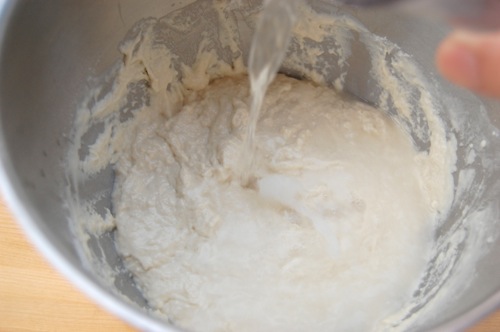
The next day pour off the excess water.
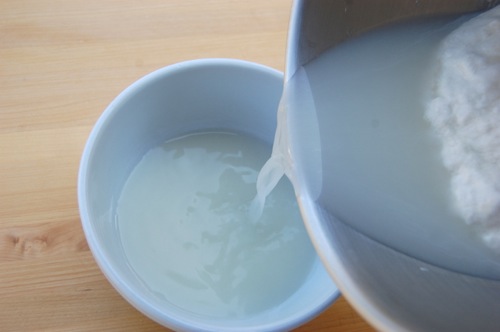
Re-attach the bowl to the mixer, put on the paddle and start to beat the dough on medium-high speed. Those of you who have ever made focaccia will recognize this process. The dough starts out sticking to the sides of the mixer bowl…

…than after about 15 minutes it suddenly gathers around the paddle in a shiny mass.
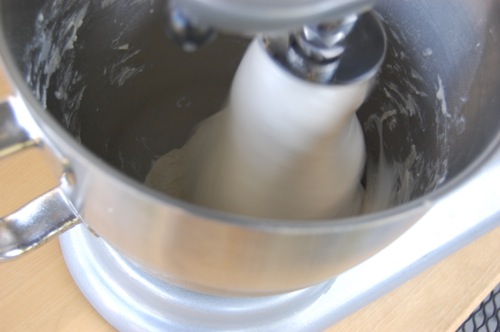
When you see this, you’re done:
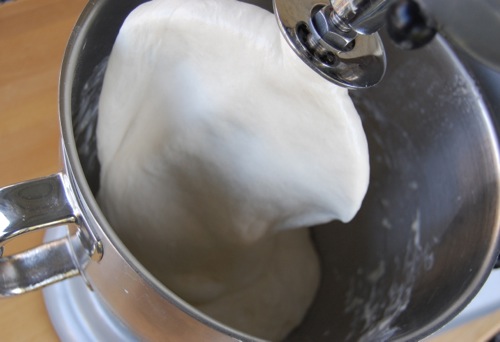
Now heat a pan over low heat. You want the temperature quite modest here, about 200 – 220 degrees Fahrenheit. I know, few if any of you have a laser thermometer handy. Another way to gauge the right temperature is to lightly touch your finger to the pan. You should be comfortable leaving it there for about a second (“one Mississippi).
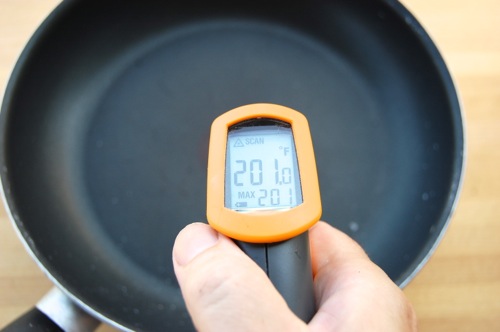
Reach into the mixer bowl and pull out the dough. It will be very floppy but all that activated gluten will make it want to hold together in one blob. You can brandish the whole thing at once or squeeze off a large piece.
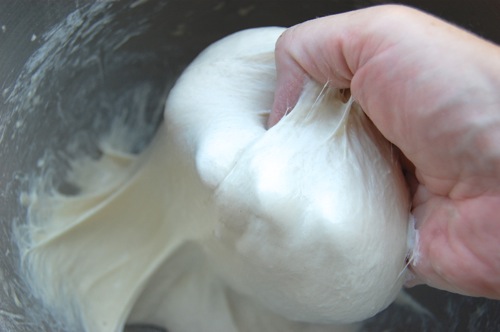
Then…juggling the whole mass in your hand…plop! Hit the pan with the dough. Swirl it a tad. Told you this was fun, didn’t I?
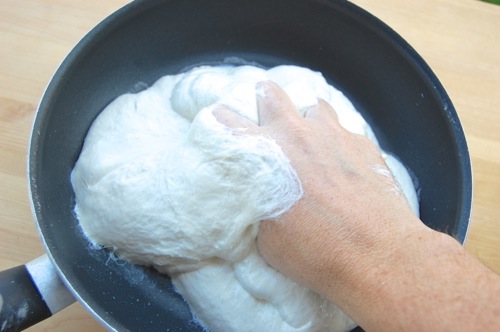
Pull it up immediately, it will come away like a large mass of glue, leaving a film like this.

Smooth out any lumps very gently with a spatula.
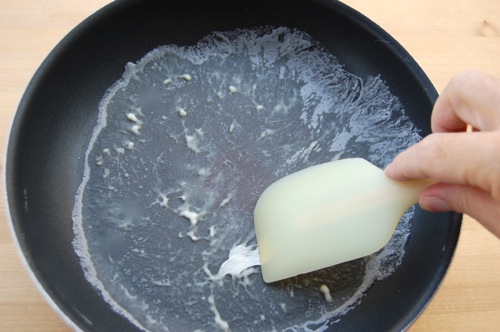
When the edges curl up the skin is done. Get under it with a spatula…
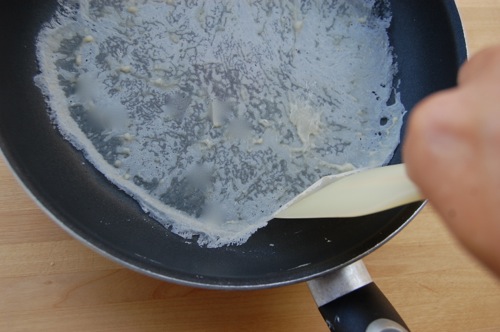
…then peel the whole thing away. I got a lot of rough edges with mine, but hey, I’m a first-timer. Plus rough edges don’t matter when you shape your rolls. Just stack them on a nearby plate covered with with damp cloth or piece of plastic wrap. They’ll be somewhat rigid at first, but will become very supple after about an hour of sitting.
Let then pan cool down again before starting the next one. About 30 seconds is good. Let it re-heat about five seconds and do the temperature test again.

To roll a spring roll, lay a skin down on a work surface. This one looks pretty ragged, but it doesn’t matter a bit. Lay on a few tablespoons of filling.
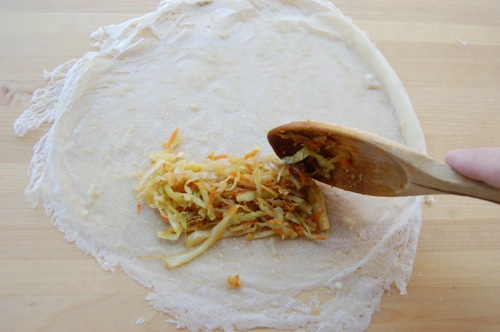
Roll it half way then fold in the sides…one…
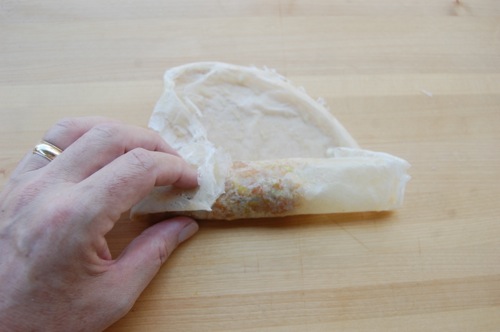
…two.
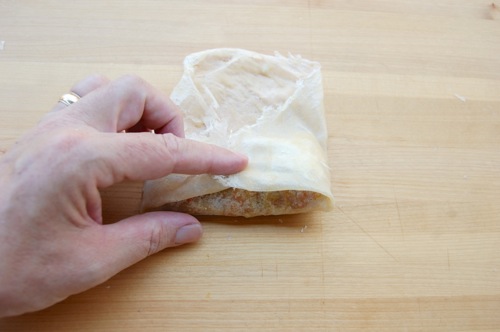
Roll it up the rest of the way and you’re done. See?
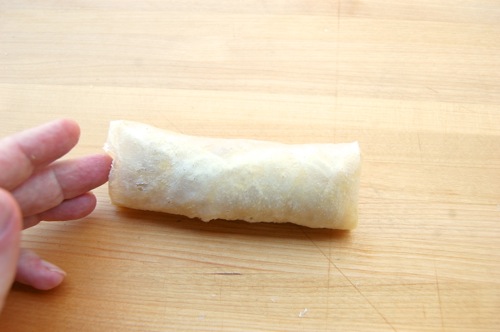
Serve them as-is or deep fry them in peanut or vegetable oil at 375 degrees Fahrenheit. You’ll want to seal the edge with a little raw egg before you do that to keep them from unraveling. Drain well and serve with horseradish mustard.
This recipe will make a whole lot of skins, but I made it large so you’d have some extra. As you get good at it, you can cut it down by a third. Oh, and did I mention these skins freeze very, very well? Indeed they do, so you can make a bunch now and store plenty away for the next Chinese meal.
Amazing technique! It looks simple and workable but who would have ever guessed?!
Not me…I was as surprised as anyone. But it’s really quite doable.
Cheers Rainey!
– Joe
Wonderful – I never even really thought about how the skins were made!
Reminds me of the unusual method for making in chow fun noodles! I can’t wait to try this.
http://www.americastestkitchenfeed.com/do-it-yourself/2012/02/how-to-make-asian-noodle-sheets/
Didn’t you make a dessert that used the swipe-gluteny-blob method to create flaky pastry? Or maybe described it before in a middle-Eastern phyllo pastry ish dessert? If so, what was the dessert?
I love seeing these unique methods. And I love egg rolls. Thanks!
Hi Mari!
Are you thinking of warqa a.k.a. brik pastry? It’s similar, though you make it by brushing a thin batter on a hot pan. I used it for a Moroccan savory pastry called bisteeya.
– Joe
Yup, that is what I was thinking of. Are there any desserts made out warqa or spring roll wraps? You’d think they would create lovely crispy flaky sweets.
There must be some, but I don’t know of any offhand. Warqa and these skins would actually be thicker that phyllo and not quite as crispy, but somewhere I’m sure someone has thought to make a sweet from them.
– Joe
Hi
Thank you for posting this… I’ve been wanting to make my own fresh spring roll skin fir the longest time 🙂
As for the recipe… It’s 1 lb + 10 oz bread flour and 1 lb + 8 oz of water ?
Just to be sure before embarking on this
Thank you
Chris
Hey Chris! Yes it’s a fairly large quantity since I thought everyone would benefit from a little extra as they tried it out. Cut it down by a third for a more “traditional” quantity. Good luck and have fun!
– Joe
I know they aren’t quite as fun as spring roll skins but .. are you willing to try wonton wrappers sometime? I’ve tried them by myself before with only satisfactory results. I’d love to see a ‘pro’ give’em a shot.
That’s interesting challenge, Rebecca. Another reader asked me to do Vietnamese rice paper wrappers…I may need to return to these sorts of things later on. Cheers and thanks for the suggestion!
– Joe
Ha! Forgot about spring rolls in my list of New Zealand Chinese foods. We have those too. Where your Chinese people had/have restaurants, the Chinese here had, and often still have, market gardens or fish and chip shops. Which is probably why all the Chinese food that we grew up with is deep fried. The sweet and sour pork, wontons, and lemon chicken are all fried in the same vats as the fish and chips, then get put in a little pottle and the sauce is poured on afterwards. Spring rolls just got wrapped up with the fish and chips in newspaper. So a typical fish and chip order might go “Two fish, a spring roll, a paua pattie, and a scoop of chips”. Don’t even really think of the spring roll as being Chinese. For years I wondered what the egg rolls in books were though; only discovered they were spring rolls not long ago.
Fascinating, and it explains quite a bit. Here in the States we’ve never had the corner chippy as an institution, which is not to say we don’t love fried foods. We just get ours at other locales. Here Chinese immigrants have traditionally owned sit-down restaurants, laundries and import shops. Also as I mentioned they were outstanding miners and railroad workers once upon a time.
Thanks for the great info, Bronwyn!
– Joe
Generalising madly again, the market gardeners’ and fish and chip shop owners’ children become dentists. That IS a huge generalisation, but enough of them do so that our dental school (we only have one in the country and it’s part of the university I work in) has many more Asian students than ones of European background. I used to get my teeth fixed there when I was a poor student and asked my Chinese/New Zealand student-dentist why the preponderance of Chinese dental students. She said it was because their parents worked hard in the market gardens and chip shops, so the children felt it was their duty to earn as much money as they could to be able to look after their parents when the get old. Dentistry is one of the best paid professions, so that’s what they aim for.
We had a shameful poll tax on Chinese immigrants back in the 1800s and early 1900s. Many Chinese men who came to work here could not afford the poll tax for their wives, so they left them behind in China. A terrible thing for a country that prides itself on its egalitarianism.
Every country has at least a few of those skeletons in its closet, I think. Here’s to better days!
– Joe
Hi Joe, we call those popiah skins, used heavily in Malaysian and Singaporean cooking.
Spring roll wrappers are something else, more like a pasta dough enriched with egg in Malaya and Singapore.
This link http://www.seasaltwithfood.com/2010/06/popiah-skin.html is good, please delete/use as you wish.
Now you’re starting to get into food I know about 🙂
Take care
Warren
I meant to put that term up, Warren…”popiah”. Thanks for adding it to the discussion. Those are excellent…much better than mine. I clearly need a lot of practice. I’m told I’m not applying enough pressure around the edges of the dough ball. Hmm…
Thanks as always for checking in!
– Joe
Great technique for the skins, looks really easy and doable.
Getting the dough right was the trick for me, but follow the procedures in the post and you should have no problem. As I mentioned, I still need to work on my technique. Ideally I’d like smoother edges!
Let me know how your go!
– Joe
I was avoiding making spring rolls…until now :))) Made it yesterday and i am overwhelmed. Delicius and easier than i thought 🙂 tnx.
Way to go, PB! Send me a picture please!
– Joe
wow i would never have guessed thats how you make the pastry! great blog post and you make it look so easy 🙂
loving your blog!
Thanks Ally!
– Joe
If I have left over spring roll skins, I usually roll up a banana (cut lengthwise and halve it the short way) Deep fry it and dust it with powdered sugar, maybe serve with some icecream!
Ooh! Yeah! Maybe a little caramel sauce!
Nice idea!
I saw this method on You Tube. 🙂 🙂 Haven’t tried it out yet.
I read about this technique before, but never tried it. Your photos really helped me wrap my head around it. Thanks!
Would fruit pie fillings work for fried skins? I’m thinking they would be closed with the same egg wash, and the skins should keep the fruit in while the roll fried. Apples, cherries, almost any firm fruit (mostly ripe banana?) could work, I think. Two served with a bit of soft-serve or whipped cream in a bowl?
I’m game to try it, Lloyd! Nice idea. Thanks!
– Joe
Oooh! In the final scene of Eat, Drink, Man, Woman – you see the daughter of a great chef (who previously eschewed her father’s cooking) making these pancakes. Only she rolled the dough around a large cast iron griddle. I always wondered how she made the dough to do that! Thanks, Joe!
Interesting. I never watched that movie all the way through. Now I will!
Thanks, Melinda!
– Joe
Thanks for sharing, Joe. Will try it at home on the weekend!!
Let me know how it goes, Roy! So far I’ve had good reports, but I’m always curious to know how people do with these sorts of projects.
Cheers,
– Joe
Hi,
Just wondering how would you store it in the freezer? do I need to put baking paper in between to prevent them from sticking on each other? or it’s fine to stack them up and freeze it?
Thanks heaps!!
Hey Colette!
Yes, I think that makes the most sense, the paper solution. But they should freeze well!
Cheers,
– Joe
hi joe, thank you for a wonderful idea. Im searching for almost a month just to know how to make a thiniest popiah skin. Your idea is perfect and a big help as well. thank u joe
For happy to help, Ann!
Cheers and thanks!
– Joe
Hi, when i made popiah skin. First one came out nicely. After that every time i try to pressure the dough on the hot pan, before i take it off dried out parts stick to the dough in the hand and it hardly stick to the hot pan. Can you please help me to figure out why it happens like this?
Thanks!
Hello Sony!
I have had that problem myself. The problem is that the pan is getting too hot. Try letting it cool a little between skins. That should fix the problem!
Cheers,
– Joe
Hi Joe,
Can you please explain the meaning of: “1 lb. 8 ounces water”
1 lb = 1 pound (0.45 kg) ?
8 ounces = 0.2268 kg ?
Thanks !
Vincente
You are correct!
– Joe